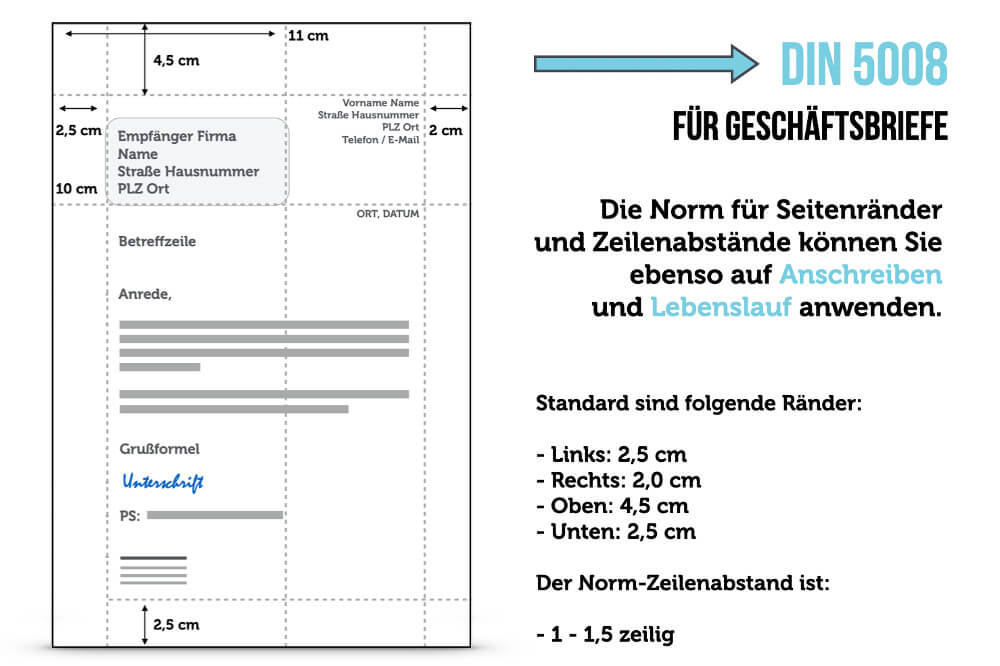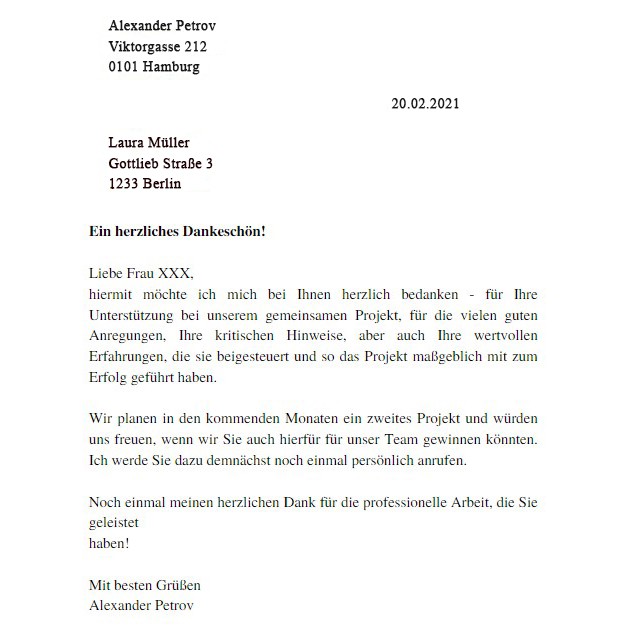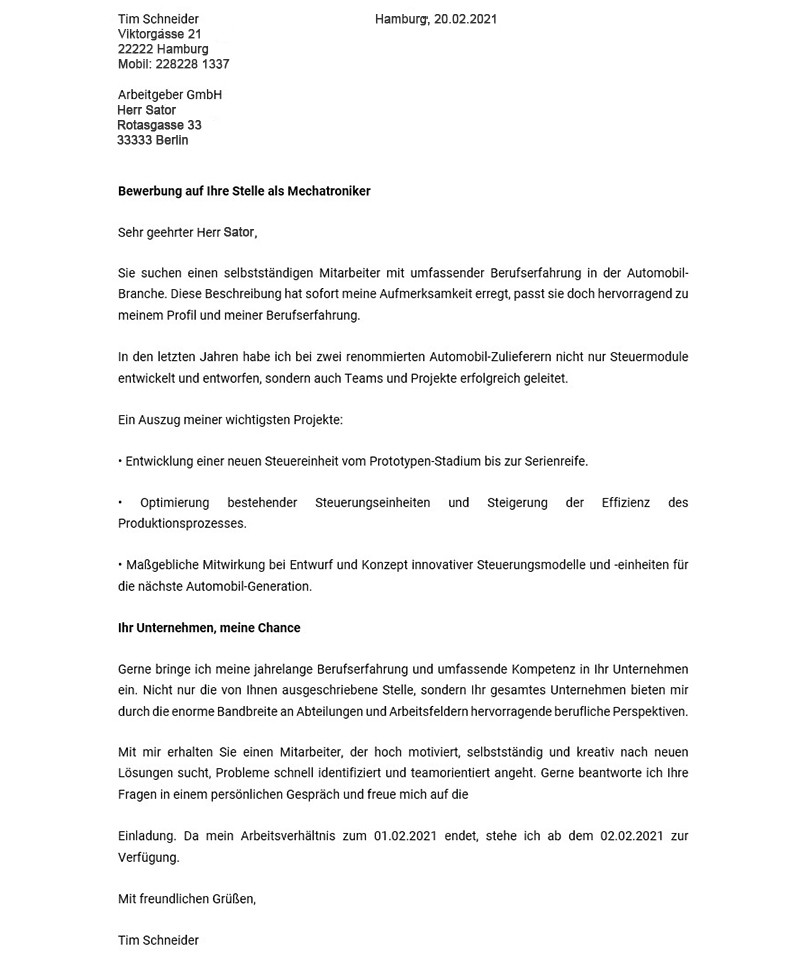How do I write a formal letter in German? Is there a mandatory structure? What are the rules of business correspondence you need to know? We have prepared for you a sample business letter in German with translation, as well as some tips for writing it.

Whether you’re sending a thank you letter, a proposal or a reminder, your business letters are always a calling card for your business. They can be used to demonstrate how professional and customer-focused your company is. Both the content and the form of the letter are crucial.
Types of business letters
Under German law, any written communication sent from outside the country by which correspondence between two business partners can be established is considered a business letter if the communication is addressed to a specific recipient or circle of recipients. Thus, the requirements for business letters in German apply in particular to:
- Offers (Angebote)
- Order and inquiry confirmations (Auftrags- und Anfragebestätigungen)
- Confirmations of receipt (Empfangsbestätigungen)
- Invoices (Rechnungen)
- Receipts (Quittungen)
- Price lists (Preislisten)
- Sales orders (Bestellscheine)
- Letters of advertisement (Werbeschreiben an namentlich im Anschriftenfeld genannte Empfänger)
- Acknowledgments (Bedanken)
Requirements for business letters in German
Germany likes to standardize and regulate, and this predilection of Germans has not escaped the notice of business letters. DIN 5008 regulates the structure and design of your letter.

Page margins
As a rule, business letters are compiled on the format of a sheet of A4. The following requirements apply to them:
- top indent: 4.5 cm
- left indent: 2.5 cm
- right indent: 2 cm
- Indent at the bottom: 2.5 cm
Font & font size
The font size in a business letter is 12. If there is an especially large amount of text, you can also reduce the letters to 11 points to make the letter fit on one page, but it should never be less than that so that your letter stays readable without problems – and that no one requires a magnifying glass to read it.
A specific font is not prescribed in DIN 5008, but Arial or Times New Roman are preferable. The font you choose may also affect the size of the font.
Letter header
The reader’s eye is immediately drawn to the layout and structure of the letter.
The sender’s address is in the top left corner by default, right-aligned or centered. The first three lines are for the name, address and phone number. You can also enter an email address here.
Three lines below that is the recipient’s address. Place and date are usually right-aligned and with a line space below the address field. However, some companies also put the date elsewhere. But the location is mentioned only if it is different from the residence (which is rare).
The subject of the email
After the letter header, we move on to the subject line. Here, in your business letters, you should be especially succinct about what the content of the letter is. However, there are certain principles you should adhere to here as well:
- The subject line of a formal letter begins two lines below the date,
- the subject line can use bold, but not necessarily (you can use a larger font – 13 to 14),
- the subject can exceed more than one line, but should not exceed two lines.
Addressing
Now begins the actual content of your business letter, and the addressing can affect how it will affect the reader. While there are countless ways to address a client, business partner, or even an employee, there are also some formal points to consider.
There are exactly two blank lines between the subject line and the address. In turn, there is only one blank line between the address and the cover letter.
A neutral address can look like this: sehr geehrte Damen und Herren (dear ladies and gentlemen). I recommend, however, that you also give the recipient’s last name in person. This way you show your respect. Even with customers, the last name is always included to show appreciation.
Speaking of addresses: How many ways do you know to say “Hello!” in German? We have made a selection of German greetings for you, so you can diversify your speech.
Main part
Of course, there can be no specific requirements for the content of your official letter that you must follow. As a rule, they are wedged into the letter template.
Letter conclusion
After you wished all the best or noted that you would welcome feedback, your business letter ends with a few short words.
Classically: Mit freundlichen Grüßen (with best regards), but it can be something personal depending on the occasion.
Don’t forget the indentation:
- One blank line between the main body and the farewell,
- between the farewell and the signature three lines – space for your signature,
- after that, possible attachments are mentioned.

An example of a German business letter
To show you what a business letter can look like, I have prepared two examples. They are designed differently and show only some of the possibilities for a formal letter in German. It is important, however, to keep (or reflect) your company’s style and image.
An example of a thank you letter

Translation
Dear Ms. XXX,
I want to thank you from the bottom of my heart for supporting our project together, for your activeness, critical comments and valuable experience which inspired you and brought the project to a successful conclusion.
We are planning a second project in the coming month and would love to have you on our team. I will let you know again in person.
Thank you again for the professional work you have done.
Regards,
Alexander Petrov
Sample Letter of Proposal

Translation
Dear Mr. Sator,
You are looking for a self-starter with extensive experience in the automotive industry. This description immediately caught my attention, it fits perfectly with my profile and experience. In recent years, not only have I developed and designed control modules for two well-known automotive suppliers, but I have also successfully managed teams and projects.
My most important projects:
- Development of a new control unit from prototype stage to series production,
- Optimization of existing control units and increasing the efficiency of the production process,
- Participation in the design and concept development of innovative models and control units for the next generation of automobiles.
Your company is an opportunity for my personal development.
I would like to bring my many years of experience and my broad competencies to your company. Not only the job you are advertising, but your entire company offers me excellent professional prospects, due to the large number of fields and areas of work.
You will find in me an employee who is highly motivated, independently and creatively seeks out new solutions, quickly identifies problems and solves them, and is team-oriented. I am happy to answer your questions in a personal conversation and look forward to inviting you for an interview. Since my previous contract ends on 01.02.2021, I am at your disposal from 02.02.2021.
Best regards,
Tim Schneider
List of abbreviations used in a business situation
| Abbreviation | Meaning | Translation |
| usw. | Und so weiter | etc |
| d.h. | Das heißt | that is |
| Vgl. | vergleiche | compare |
| z.B. | zum Beispiel | as an example |
| zzgl. | zuzüglich | plus |
| ggf. | gegebenenfalls | if necessary |
| a. O. | Am angegebenen Ort | at the specified location |
| gez | gezeichnet | signed |
| Abb. | Abbildung, -en | Figure, -s |
| Kto. | Konto | account (in a bank) |
| Abt. | Abteilung | department |
| Adr. | Adresse | address |
| allg. | allgemein | generally |
| Best.-Nr. | Bestellnummer | order no. |
| bspw. | Beispielsweise | for instance |
| bzgl. | bezüglich | regarding |
| ca. | circa | approx. |
| Hrn. | Herrn | gentlemen |
| Hr. | Herr | Mr |
Tips for writing a business letter
After so much information, the question still remains: How do you write a good formal letter in German that conveys the most important content, does not seem boring, and, at its best, leads to a quick response or response from the recipient? We’ve put together ten tips to help you write not only a professional letter, but also a successful business letter.
Keep it short (remember: your reader’s attention span is not unlimited).
→ Clearly state the purpose of your letter (the subject line displays a summary of your letter).
→ First formulate the most important thing in your message (already in the first or second sentence it should be clear to the addressee why you are addressing him).
→ Pay attention to the addressing (Sehr geehrte Damen und Herren – this is a standard address, and purely formally it will not do anything wrong with the letter. But it also looks impersonal, cold and detached: who are these ladies and gentlemen? In short, it lacks soul. To know what kind of address is appropriate for your letter, you should ask yourself two questions: Do you know the name of the recipient? How well do the author and the recipient know each other? If your answers are “no” and “no,” your choice automatically falls to “Dear Ladies and Gentlemen.” If you know the name of the recipient, but the case of your letter is formal, it is recommended to resort to Sehr geehrte/r Frau/Herr X. If your connection is more intimate, you can use Guten Tag or Liebe/r).
→ Put your addressee in the spotlight (before composing your letter, ask yourself: who is the addressee? What is he or she interested in? What value can you offer him or her? When writing, use the word “you” instead of “we” more often. Better yet, write “you will receive our free consultation” instead of “we offer you a free consultation”).
→ Do not use outdated phrases (Werte/r Frau/Herr X or Verehrte/r Frau/Herr X, Hochachtungsvoll – with deep respect – these are no longer used today).
→ Formulate positive statements (instead of Leider können wir Ihnen das Produkt nicht liefern (sorry, we cannot provide you the product) it is better to formulate the answer as “we will take care of the quickest possible delivery of the product you want and will inform you as soon as it is in stock”. The second makes your business letter look much more professional, positive and customer-focused).
→ Leave a feedback option (at the end of your letter, you should give the recipient the opportunity to contact you with any questions).
→ Choose a modern way of saying goodbye (there are many good alternatives to the usual Mit freundlichen Grüßen – with best wishes. A more informal option is to write, for example, Mit besten Grüßen – all the best. Or choose an original greeting formula adapted to your company, such as Mit kulinarischen Grüßen – with culinary greetings – for gastronomy or Mit sportlichen Grüßen – with sporting greetings – for sporting goods and fitness center. The wording of the goodbye is usually well remembered and should therefore be chosen wisely).
→ Use a postscript (P.S. gives you the option of including an addendum at the end of the letter. For example, here you can refer to the current sentence or your online presence – and be sure that every reader will pay attention to it, because the P.S. always catches the eye).
Do you want to get your German language learning planner?
Dive into a World of German Mastery with Leo. Over 7500 enthusiasts are already unlocking the secrets to fluency with our tailored strategies, tips, and now, the German language learning planner. Secure yours today and transform your language journey with me!






